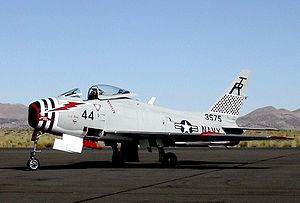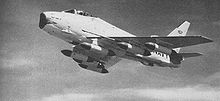North American FJ-4 Fury Video - Belly Landing
|
|
 Picture: The last flying FJ-4 in United States Navy colors
Picture: The last flying FJ-4 in United States Navy colors
Role - Fighter aircraft
National origin - United States
Manufacturer - North American Aviation
First flight - 28 October 1954
Retired - late 1960s
Primary users - United States Navy
United States Marine Corps
Number built - 374
Developed from - FJ-2/-3 Fury
The North American FJ-4 Fury was a swept-wing carrier-capable fighter-bomber for the United States Navy and Marine Corps. The FJ-4 featured an entirely new wing design, and in the end had little in common with the earlier FJ-3 apart from its general layout and engine.
Design and development
Compared to that of the FJ-3, the FJ-4's new wing was much thinner, with a six percent thickness-to-chord ratio, and featured skin panels milled from solid alloy plates. It also had an increased area, and tapered more sharply towards the tips. Slight camber behind the leading edge improved low speed characteristics. The main landing gear design had to be considerably modified to fold wheel and strut within the contours of the new wing. The track of the main wheels was increased and because they were closer to the center of gravity, there was less weight on the nosewheel. Wing folding was limited to the outer wing panels.
 Picture: An FJ-4B with six rocket pods
Picture: An FJ-4B with six rocket pods
 Picture: FJ-4F prototype with an additional rocket motor
Picture: FJ-4F prototype with an additional rocket motor
The FJ-4 was intended as an all-weather interceptor, a role that required considerable range on internal fuel. The FJ-4 had 50% more fuel capacity than the FJ-3 and was lightened by omitting armor and reducing ammunition capacity. The new wing was "wet"; that is, it provided for integral fuel tankage. The fuselage was deepened to add more fuel, and had a distinctive "razorback" rear deck. A modified cockpit made the pilot more comfortable during the longer missions. The tail surfaces were also extensively modified and had a thinner profile. The overall changes resulted in an aircraft that had little in common with the earlier models, although a family resemblance was still present. The two prototypes had the same Wright J65-W-4 engine as the FJ-3, but production aircraft had the J65-W-16A of 7700 lb thrust.
The first FJ-4 flew on 28 October 1954 and delivery began in February 1955. Except for one squadron which trained Navy FJ-4B pilots, FJ-4s were used exclusively by the Marine Corps, which operated three squadrons.
Of the original order for 221, the last 71 were modified in the the FJ-4B fighter-bomber version. This had a stronger wing with six instead of four underwing stations, stronger landing gear. Additional aerodynamic brakes under the aft fuselage made landing safer by allowing pilots to use higher thrust settings, and were also useful for dive attacks. External load was doubled. But the most important characteristic of the FJ-4B was that it was capable of carrying a nuclear weapon on the inboard port station. It was equipped with the LABS or Low-Altitude Bombing System for the delivery of nuclear weapons. The Navy was eager to maintain a nuclear role in its rivalry with the Air Force, and it equipped ten squadrons with the FJ-4B. It was also flown by three Marine squadrons. In April 1956 the Navy ordered 151 more FJ-4Bs, bringing the production to a total of 152 FJ-4s and 222 FJ-4Bs.
The Navy ordered six FJ-4s to be converted to FJ-4F to test rocket engines, but only two were completed. These featured the North American Rocketdyne AR-1 engine, installed in a fairing above the tail pipe of the jet engine. It ran on hydrogen peroxide and JP-4 jet fuel, and provided an additional 5000 lb of thrust for short periods. The FJ-4F reached speeds of Mach 1.41 and altitude of 71,000 ft (21,640 m).
Redesignation
With the new designation system adopted in 1962, the FJ-4 became the F-1E and the FJ-4B the AF-1E. AF-1Es served with United States Naval Reserve units until the late 1960s. A total of 1,115 Furies were received by the Navy and Marine Corps over the course of its production life.
Variants
XFJ-4
Two prototypes with a J65-W-4 engine and re-designed fuselage.[1]
YFJ-4
One FJ-4 used for development testing.[1]
FJ-4 Fury
Single-seat fighter-bomber version, powered by a 7,700 lbf (34.3 kN) Wright J65-W-16A turbojet engine. 150 built.[1]
FJ-4B Fury
Single-seat ground-attack close support version with 6 underwing pylons, 222 built.[1]
FJ-4F Fury
Test and evaluation aircraft, fitted with an auxiliary rocket motor and supplementary fuel tank. Two conversions fom FJ-4.[1]
F-1E Fury
Redesignation of the FJ-4.[1]
AF-1E Fury
Redesignation of the FJ-4B.[1]
Specifications (FJ-4)
Data from American Military Aircraft[2]
General characteristics
Crew: 1
Length: 36 ft 4 in (11.1 m)
Wingspan: 39 ft 1 in (11.9 m)
Height: 13 ft 11 in (4.2 m)
Wing area: 338.66 ft² (31.46 m²)
Empty weight: 13,210 lb (5,992 kg)
Loaded weight: 20,130 lb (9,130 kg)
Max takeoff weight: 23,700 lb (10,750 kg)
Powerplant: 1× Wright J65-W-16A turbojet, 7,700 lbf (34 kN)
Performance
Maximum speed: 680 mph (1,090 km/h) at 35,000 ft (10,670 m)
Range: 2,020 mi (3,250 km) with 2× 200 gal (760 l) drop tanks and 2× AIM-9 missiles
Service ceiling: 46,800 ft (14,300 m)
Rate of climb: 7,660 ft/min (38.9 m/s)
Wing loading: 69.9 lb/ft² (341.7 kg/m²)
Thrust/weight: .325
Armament
Guns: 4 × 20 mm (0.787 in) cannon
Missiles: 4 × AIM-9 Sidewinder missiles
Bombs: 3,000 lb (1,400 kg) of underwing ordnance, including missiles
Related development
FJ-1 Fury
FJ-2/-3 Fury
F-86 Sabre
F-100 Super Sabre
Comparable aircraft
Dassault Mystère
F3H Demon
F-84F Thunderstreak
Mikoyan-Gurevich MiG-15
Mikoyan-Gurevich MiG-17
Supermarine Scimitar
References
Notes
1. a b c d e f g Andrade 1979, p. 190
2. Humphrey, Hal and Joe Baugher. | "North American FJ-4 Fury." American Military Aircraft: US Navy Fighter Aircraft, revised 4 January 2008.
Retrieved: 29 April 2008.
Bibliography
Andrade, John. U.S.Military Aircraft Designations and Serials since 1909, Midland Counties Publications, 1979, ISBN 0 904597 22 9
Avery, Norm. North American Aircraft 1934-1998 Volume 1. Santa Ana, CA: Narkiewicz/Thompson, 1998. ISBN 0-913322-05-9.
Bowman, Martin. F-86 Sabre. London: Airlife, 2004. ISBN-1-84037-411-X.
Dorr, Robert F. "North American FJ Fury." Aeroplane Monthly, February 2006..
Dorr, Robert F. "Fury: The Navy's Sabre." Air International, January 1993.
Taylor, John, W.R., ed. "North American FJ Fury." Jane's All the World's Aircraft 1965-1966. London: Jane's All the World's Aircraft, 1967.
ISBN 0-71061-377-6.
Wagner, Ray. The North American Sabre. London: Macdonald, 1963. No ISBN.
Wilson, Stewart. Combat Aircraft since 1945. Fyshwick, ACT, Australia: Aerospace Publications Pty Ltd., 2000. ISBN 1-875671-50-1.
Wilson, Stewart F-86 Sabre / MiG-15 Fagot / Hawker Hunter. London: Aerospace Publications Pty Ltd, 1995. ISBN 1-875671-12-9.
Winchester, Jim, ed. "North American FJ Fury." Military Aircraft of the Cold War (The Aviation Factfile). London: Grange Books plc, 2006. ISBN
1-84013-929-3.
Living Warbirds: The best warbirds DVD series.
Source: WikiPedia